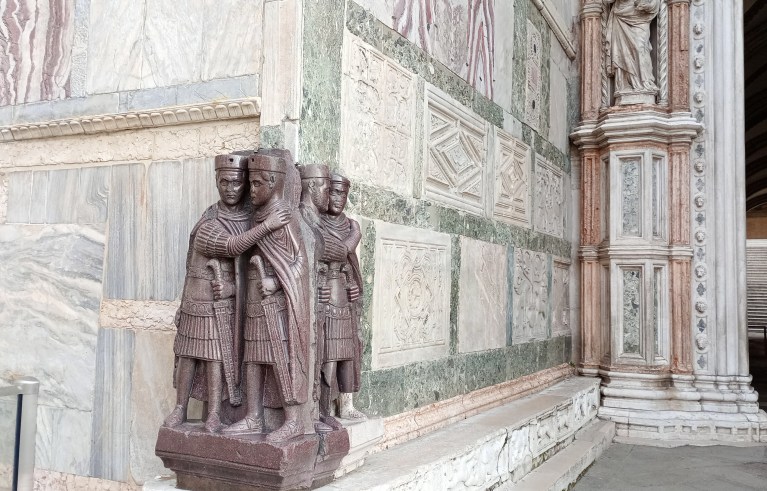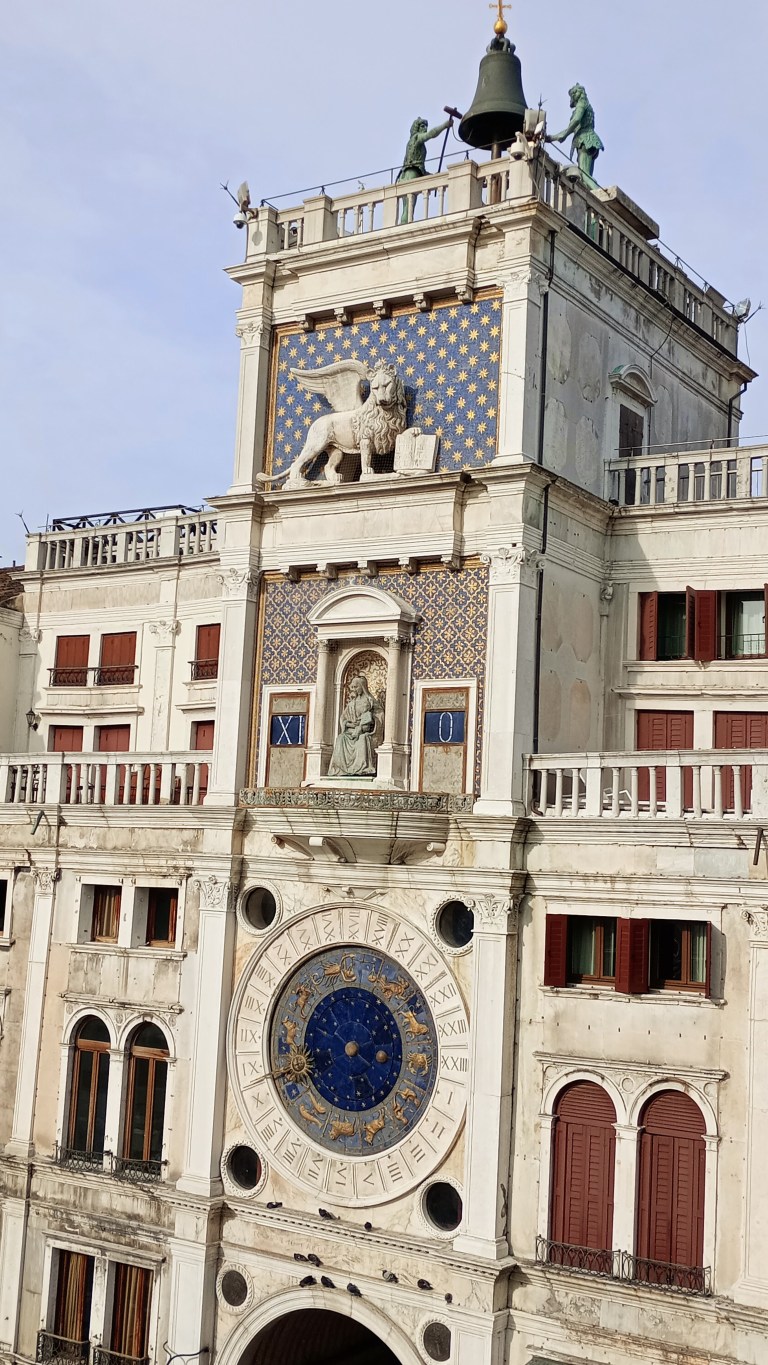Today we finish off Athayde Tonhasca Júnior’s recent trip to Venice (the first part is here). His notes are indented and you can enlarge the photos by clicking on them.
One of the history’s delights is the opportunity to pull a thread of successive events that help us understand better today’s world. These fabulous bronze horses inside St Mark’s Basilica (the ones on the facade are replicas) were pilfered from Constantinople, the capital of the Byzantine Empire, when the city was sacked by Frank crusaders and Venetians in 1204. The Fourth Crusade was kicked off by Pope Innocent III – an ironic name if ever there was one – who had no idea of the shitstorm he was unleashing. Despite his angry threats of excommunication, the Crusaders, who were supposed to go to Jerusalem, stormed Constantinople and massacred their Christian brethren in an orgy of rape, disembowelments and decapitations. The city was razed to the ground and the Byzantine Empire never recovered, becoming easy pickings for the invading Ottomans in 1453. For a cut of the profits, the Venetians provided transport and gave all the logistical support to Innocent’s road trip from hell – so you could say they are largely responsible for Constantinople becoming Istanbul. Incidentally, the Venetians had the perfect leader for this rapacious adventure: the nonagenarian and blind Doge Enrico Dandolo (you can read the details in Roger Crowley’s City of Fortune, an excellent account of Venice’s history). To this day, the Fourth Crusade is a sore subject for Orthodox Christians:
Another souvenir pinched from Constantinople: The Four Tetrarchs, probably depicting the four rulers that took over the Roman Empire in 293 AD. The Byzantines considered themselves Greek-speaking Romans (Romaioi), so Rome’s past was their past. Notice the mismatched foot in one of the figures; the original bit broke off when the statue was hacked away. The heel of the missing foot was discovered in 1960, and it’s on display in the Istanbul Archaeology Museum:
Some armies would go to war with their dull and ugly artillery pieces. Not the dazzling Venetians, as attested by this 1643 culverin (an early type of cannon).
The End. These pens in the Naval Museum were used by Napoleon Bonaparte to sign the treaty of Campo Formio on 17 October 1797, thus ending five years of war between the French Republic and the First Coalition. France and Austria swapped several bits of territory, redrawing the map of Europe. In the process, Venice was swallowed by Austria. After 1,100 years, La Serenissima was no more:
Venice’s resident population dropped below 50,000 in 2022, down from 66,000 20 years ago and 175,000 in the 1950s. Locals are leaving, fed up with mass tourism and the cost of living. But there’s plenty of old Venice still left:
Rotund tourists may struggle in a calle stretta (a narrow alley; calle Varisco is 53 cm wide). These alleys branch out in every direction and don’t lead you to any specific place; they are used by residents to get home. Many of these thoroughfares are not on the maps and are beyond phone signal reach, so good luck finding your way. While you wander around baffled and disorientated, stay on good terms with the natives by keeping to the right and in a single queue:
A helpful but scarce street sign: ‘the whores’ gate’, where presumedly clients were serviced while standing up against the calle‘s walls:
Venice’s historic centre comprises 121 islands linked by 435 bridges. Shopping, public transport, ambulances, rubbish collection, home delivery, postal service and everything else depend on the canals network:
Having a go at describing our wine during a midday victualling: meandering, medium-bodied, bordering on the reckless at the quantum level. Hints of peach-pits, boysenberries and biodynamic hand-cultivated cacao from a coastal Tuscan villa; cleansing, metallic tannin waltzing with sweet-sour rosehip and balsamic vinegar; co-habiting with sumptuousness that does not bully a goat spleen escabeche. An approachable companion for self-medication any time of day (h/t many sources). Ok, I was a little off. Some wine people must have great fun composing these pretentious servings of tripe. In rural Italy, you can’t go wrong by ordering description-free vino della casa (house wine). It may come in a faceless bottle or jug but is invariably good. No respectable restaurant will risk its reputation with the locals – never mind tourists passing by – by offering plonk. That principle doesn’t apply to big cities:
You can eat well and not be ripped off in Venice – or anywhere else. Stay clear of tourist hangouts, bypass the dreadful menù fisso (fixed price but little choice) and don’t trust reviews – most of them are written by people used to overcooked pasta and abominations such as pineapple pizzas and spaghetti Bolognese. Instead, follow the locals. We had two excellent meals in this unassuming osteria, which is patronised by neighbours and vaporetto (public waterbus) workers.
The superb Renaissance-kitsch Torre dell’Orologio (Clock Tower), built in 1496/1497. The two bronze figures on top are hinged at the waist to strike the bell on the hour. They are supposed to be shepherds, but are known colloquially and politically-incorrectly (Italians are not oversensitive about these matters) as ‘the Moors’ because of their dark patina. Below them is the winged lion of St. Mark, followed by Virgin Mary with her offspring flanked by two blue panels: the left shows the time in Roman numerals, while the right indicates 5-min intervals in Arabic numerals. Finally, the clock, displaying the time, the phase of the moon, and the dominant sign of the Zodiac. The clock’s mechanism beats any Casio: it has been working since 1753:












I just enjoyed a delightful morning in Venice.
Fascinating, and useful tips!
Thanks for another great set and commentary. I spent a couple of days getting lost in the Venetian maze with a girlfriend in the early ’80s.
Thank you for the tour! The wine you had sounds interesting! Why is that no description of wine—not even your fanciful one—mentions the flavor or aroma of, well, grapes?
That is the first time I’ve seen an analog clock showing 24 hours. It is interesting that midnight is at ‘3 o’clock’ on a conventional 12 hour clock face. It must play havoc with kids learning to read an analog clock. Lovely pictures!
We visited Venice at the end of September, hoping to have better weather and fewer tourists than in summer. The weather was fine but tourists were still a little more than you’d want. Not bad though. Tourism is on the rise and they are going to implement a fee on visitors starting this year as a test. 5 Euro to enter the city unless you stay overnight.
You are indeed fortunate if you are able to see it. And there is much to see. As a student of Renaissance art, I was in historical heaven.
Wonderful – thank you!